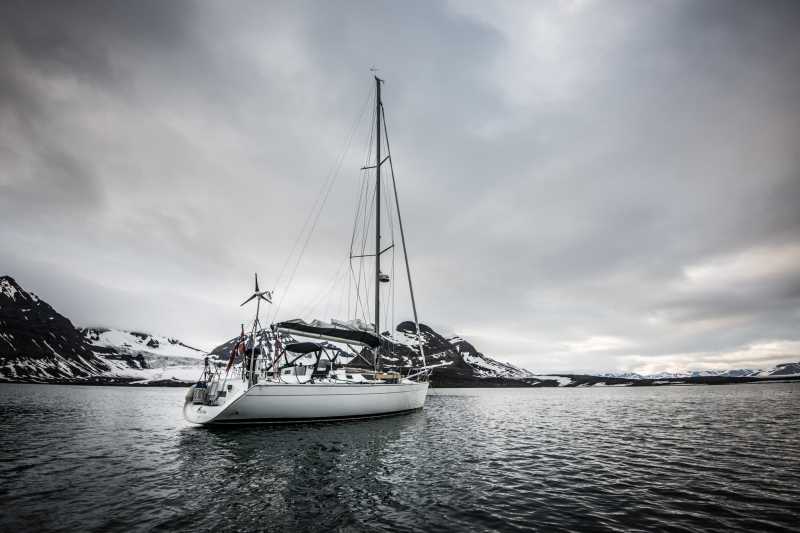It was 2AM on Friday when we finally sailed out of Tromsø. Barba sat heavy in the water, loaded with provisions, diesel and all manner of gear for 40 days up in the North. After eight hours we found ourselves facing the open ocean, with three days of transit ahead of us. We started out sailing at a decent speed of 7 knots. The next day, however, the wind left us. In dead-calm seas we had quite an enjoyable time wearing the very minimum of the unofficial onboard uniform – long wool underwear pants and a t-shirt are as tropical as sailing on Barba gets. It felt like the last farewell to the warmer climate. Some 12 hours later, Barba was once again being propelled by the wind and the temperature had dropped to around 8 degrees Celsius. Writing about this now, it´s all a bit misty in the mind. With constant daylight, it´s difficult to tell the days apart, night from day, midnight from high noon. But around half way into our journey I could see Bear Island through the fog, about 15 nautical miles to the east. It´s a place we intend to visit on the way back. A minke whale revealed itself with an outburst of air. For the three day at seas we only saw two other boats, and no airplanes in the sky. We were never alone, though. On three occasions we had dolphins playing around the boat and numerous whales were observed, although at distance.
For our last day of sailing the wind picked up nicely. We tried to stay as close as possible to it, to make it to the Southern Cape of Svalbard. As most capes do, this one puts a mark on its surroundings with increased wind speed, choppy water and strong currents. With three reefs in the main sail and sailing at 7 to 8 knots, most of us were having quite an enjoyable time. As Jon and I had a chat on the deck, the first iceberg came unexpectedly into sight, some six hours before we´d reached land. It was about the size of a school bus. We were of course very excited by this early sign indicating that we were on the right path.
Others in our crew, however, were enjoying themselves slightly less. Barba was, after all, in the open sea. And people and inventory were being tossed around and pinned relentlessly portside. There was a lot of time being spent as horizontal as possible in the cabins. And Ivan experienced an involuntary bathroom visit, as he launched backward from the galley while cooking and slammed through the head´s door. We agreed it was a good thing it was not occupied at the time. Sometime late in the evening on Saturday, we could finally see land through the fog. We worked our way up north to Hornsund (see the satellite tracker for position). Hornsund is a fabled land, with steep glaciers covering the mountainsides, icebergs floating in the water and reindeer grazing on land.
Our first anchorage was not very successful. After about 30 minutes, strong wind deprived Barba from her rest. It was all hands on deck to get on top of the situation. According to the pilot guide, this spot was the best anchorage in the fjord. We found a better one further in, however, completely sheltered from both ice and waves. And this is where we launched the dinghy and were able to put our feet on dry ground for the first time in four days. In our yellow sailing suits, we looked a bit like space explorers wandering around a sandy black moonscape. We quickly realized that we were not alone, however. The beach and ridge leading up from it were covered in polar bear tracks. And while we haven´t sighted the king of the Arctic so far, we are constantly on the alert. We are on day two of our Svalbard visit now, preparing for a glacier hike and paragliding. Barba life, at the moment, is as good as it gets.
Featured photo: Barba and crew resting at anchor, in Horsund, Svalbard.
Andreas


Polar bear tracks. That says it all!